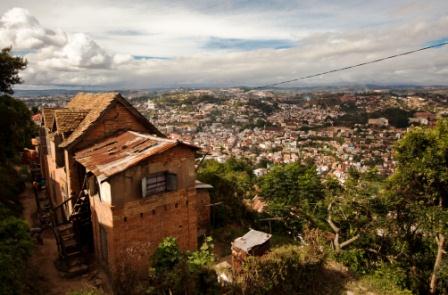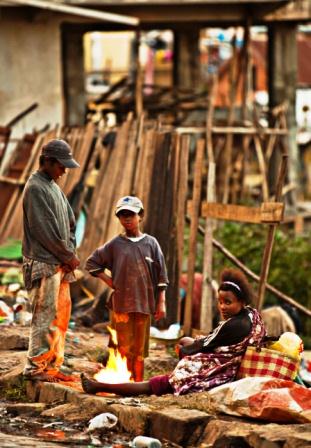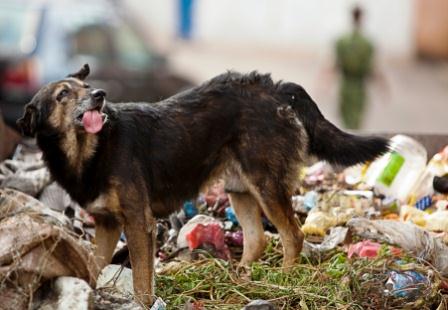Bug-Eyed Over Lemurs!
Arriving in Madagascar, Embarking for Adventure
 Kasey-Dee Gardner
Kasey-Dee Gardner
After a day’s travel, Dan and I arrive in Antananarivo, Madagascar’s capital city. The weather is beautiful, a cool breeze surrounds us the instant we leave the airport. It feels good to get off a plane. A driver meets us at the airport and takes us to the city center where we plan on spending the next few days.
Driving through the capital city of about a million people, the sights, sounds and smells shouldn’t be surprising—Madagascar ranks as one of the world’s poorest countries—but they still are. Kids run through the streets, dirty, wearing scraggly donated clothes, looking malnourished. Beggars and wild dogs fight for street corners. Farm animals rule the roads. Traffic clogs the city and the pollution is overwhelming.
 But, the one thing that really shocks me is the number of people carrying slabs of timber through the streets. I’ve read about the gangs who are deforesting the land and I’m wondering if that’s what I’m seeing. These gangs, which rose to prominence during Madagascar’s political crisis, are partially responsible for stripping the country of its most vital resource – the forest. Political instability during the past year has resulted in an economic spiral — with tourism suffering and an already impoverished country fending for itself, with illegal deforestation and a host of other environmental issues.
But, the one thing that really shocks me is the number of people carrying slabs of timber through the streets. I’ve read about the gangs who are deforesting the land and I’m wondering if that’s what I’m seeing. These gangs, which rose to prominence during Madagascar’s political crisis, are partially responsible for stripping the country of its most vital resource – the forest. Political instability during the past year has resulted in an economic spiral — with tourism suffering and an already impoverished country fending for itself, with illegal deforestation and a host of other environmental issues.
Once we check into our hotel (constructed entirely of wood), Dan and I unload our bags and hit the streets. Walking through the city, we feel no real sense of political turmoil. Every so often, we pass heavily armed guards patrolling the streets, which leaves me feeling jittery at first because Dan and I stand out so dramatically. But, even though there’s a political power struggle, neither of us sense any trouble.

The city smells like a mixture of burning garbage and human waste. We wind up the narrow, cobblestone streets to find a place to eat. Because of the presence of foreign embassies and constant influx of foreign aid workers, there’s a solid choice of ethnic eats to choose from in Antananarivo. We pick a little Mexican restaurant, because it’s the only menu we can comfortably understand in French.
From everything I’ve read, I’ve been expecting Madagascar to be a bit like India. — street children surrounding me, trinket vendors following me for blocks at a time, and people constantly asking for money. But that doesn’t happen. It’s not like that at all. Malagasy people, as a whole, are some of the nicest, most respectful people I’ve ever met.
There’s not much to see in Antananarivo besides the Queen’s old palace, La Rova, which is closed for renovation, the city center lake, Lac Anosy, and the small art shops that line the street. So our biggest priority is heading out of town to check out what’s we came here for: lemurs!
We line up a driver, translator and guide for the next two weeks. And then Dan and I crash for the night to sleep off the jet lag and begin our wild adventure.
Photos: Dan Plimpton
Related links:
New Scientist writes about the wood and lemur trade.
This non-profit supports the orphans of Antanananrivo.
Earthwatch conducts scientific research.
Conservation International is helping preserve the forests.
National Geographic has an article on Lemur Looting.
The New York Times has an article on Malagasy Deforestation.
